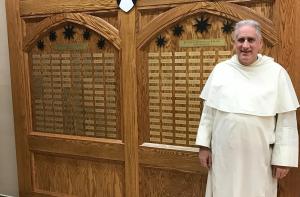‘Coaching soccer at Fenwick is integral to my ministry as a Dominican Friar’ — especially in the heat of battle!
By Father Dennis Woerter, O.P. ’86

Pelé, whom I consider to be the greatest soccer player of all time, said, “Success is no accident. It is hard work, perseverance, studying, sacrifice and most of all love of what you are doing or learning to do.” Certainly, he had much success, helping Brazil win three World Cups and currently holding the fifth spot in the list of top World Cup goal scorers, with 12. At Fenwick, we want our students to be successful, and we never shy away from the fact that success requires hard work, perseverance, studying, sacrifice and love. Pelé’s words apply to us all!
I have coached both boys’ and girls’ soccer at Fenwick for six years, beginning with the fall season in 2012. Soccer strategy is the same for both: Coaches adapt formations to the personnel and make adjustments throughout the season. The skills are the same for all who play soccer, but there is a lot more to the game than winning and losing.

I tell my players before the first game to “remember the shield.” When on the field, they represent Fenwick; and referees, opponents, opposing coaches and spectators notice the ways in which a team respects all aspects of the game. It is telling that the Fenwick boys’ soccer program has won the Chicago Catholic League Sportsmanship award a few times! This award is given to the entire program.
It is important, though, to reflect on how coaching soccer at Fenwick is integral to my ministry as a Dominican Friar. I played soccer at Fenwick and Loras College. Fenwick had started soccer in 1981, so my freshman year of 1982 was the second year of varsity soccer. Both our boys’ and girls’ programs are now consistent winners. My first year at Loras (1986) was their first year as an NCAA program. They are now a Division III powerhouse!
Pele’s words resonate for us as coaches. We work our players hard. We encourage them to keep going when they may want to give up. We have classroom sessions where we design plays and explain strategy. When faced with obstacles, coaches figure out new ways of integrating team personnel. The demands of a season result in coaches and players spending a lot time away from home. Most important of all, though, we share the love of the sport with those we are charged to coach. This love is not only for the sport, but for the players we coach.

The foundation of ministry is forming relationships. Coaching is a lot like ministry. In order to be a successful coach, relationships must be formed with players. In order to influence players, they must see the coach as someone who is competent and compassionate! The coach also must have the player’s best interest in mind.
This can be exemplified by an experience I had during a game last spring. We were winning a particular game, but one of the referees was one we had trouble with before. During the course of the game, he showed some amazing disrespect to me by some things he said. I reacted by saying some things only the girls on the bench could hear. One of them, a captain, led me aside and said, “FD (my nickname), don’t lower yourself to his level. We all know you are right.”
Notice, she didn’t say, “I know you are right.” She said, “We know.”
About the Author
 A Class of 1986 alumnus, Fr. Woerter teaches Theology at Fenwick and is the Director of Campus Ministry. Father Dennis (FD) also coaches as an assistant on the sophomore boys’ and junior-varsity girls’ soccer teams. He received a B.A. in speech communication (journalism) from Loras College, a Master of Divinity from the Aquinas Institute of Theology, a M.A. in Theology (Catholic Social Teaching) from the Aquinas Institute and a Doctor of Ministry degree (Preaching in the Practice of Ministry) from the Iliff School of Theology.
A Class of 1986 alumnus, Fr. Woerter teaches Theology at Fenwick and is the Director of Campus Ministry. Father Dennis (FD) also coaches as an assistant on the sophomore boys’ and junior-varsity girls’ soccer teams. He received a B.A. in speech communication (journalism) from Loras College, a Master of Divinity from the Aquinas Institute of Theology, a M.A. in Theology (Catholic Social Teaching) from the Aquinas Institute and a Doctor of Ministry degree (Preaching in the Practice of Ministry) from the Iliff School of Theology.
















